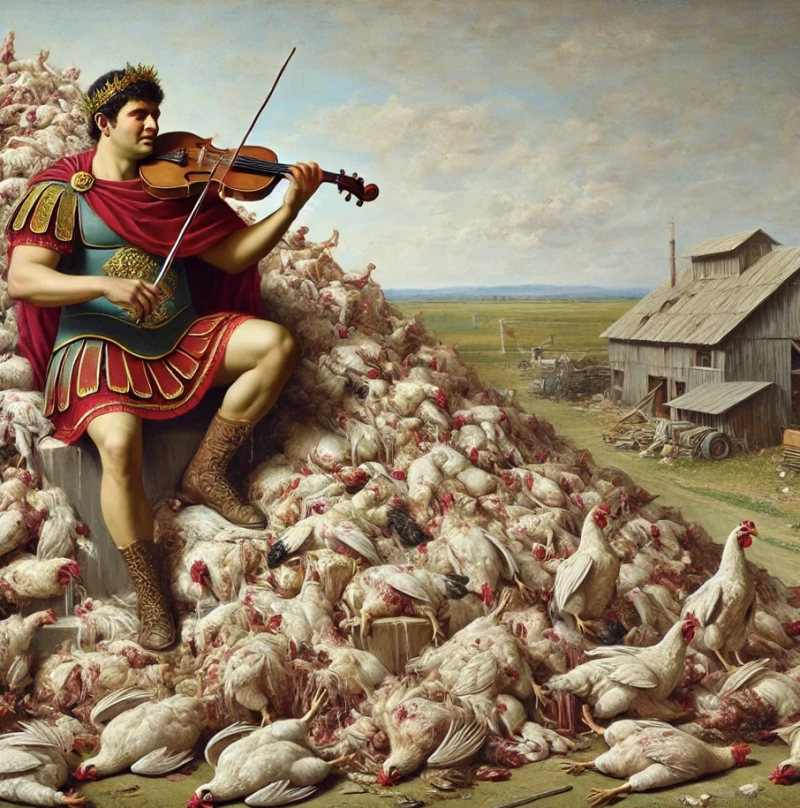Egg industry scrambling: Today’s Neros fiddle as the bird flu crisis deepens while politicians and ideologues ignore solutions to the crisis
Egg industry scrambling: Today’s Neros fiddle as the bird flu crisis deepens while politicians and ideologues ignore solutions to the crisis


A bulldozer belches a black cloud of exhaust as the engine revs. A mound of dead chickens flops into a hole in the earth.
Highly Pathogenic Avian Influenza (HPAI caused by the H5N1 virus) is now threatening domestic wild bird flocks. Infection spreads fast, and affected birds die within days, suffering from respiratory, neurological and digestive distress. In the latest U.S. outbreak over 166 million domestic chickens have died from disease or been culled in infected flocks, 280 million worldwide.
The result has been a sharp increaase in egg and meat chicken prices, with impacts to certainly affect turkey populations as well. In many places, limits are in place on eggs to reduce hoarding. Whether locked out by price or availability, many of the poorest have lost access to a nutritious food staple entirely.
Here’s the most challenging issue: the economic consequences will not be short lived. As flocks are euthanized or die from infectious disease, replacement birds require half a year to mature to egg laying age. That is, if egg producers can find chicks to grow, as millions of replacements are needed, and even hatcheries have been affected.
And with every subsequent infection the odds of zoonotic jumps to humans, livestock and domestic animals increase. We stand a mutation, an exposure, and an ambitious traveling salesman away from the next economically disastrous and deadly pandemic.
But it does not have to be this way. There are several strategies to slow and perhaps stop HPAI, some demonstrated effective over 14 years ago. However, due to a rejection of technology, birds will continue to die, and consumers will endure higher costs and less access to eggs.
Here’s how genetic engineering can help
One brilliant and still unapplied approach to curbing HPAI was published in 2011. A joint effort between The Roslin Institute at the University of Edinburgh and University of Cambridge created chickens that could become infected with HCAI, but could not transmit the virus. These birds were an epidemiological dead end, cutting off the possibility of passing along the deadly disease.
The technology is brilliant, but simple. The H5N1 virus genome encodes a three-subunit polymerase (the enzyme that synthesizes nucleic acids) that it uses to replicate its RNA genome. The polymerase initiates the process at a specific sequence in the viral RNA genome, binding this sequence prior to replication.
Dr. Helen Sang and colleagues genetically engineered chickens to express an RNA sequence bearing the same replication-machinery-sequestering sequences, only with nothing attached to replicate. It is a decoy that captures the machinery needed for viral replication, pulling it away from the job of creating more viruses. Huge amounts of this synthetic decoy sequence are produced within every cell, and recruit the viral replication machinery, away from the virus itself. In other words, the scientists genetically engineered in a sequence that siphons required replication proteins to biochemical doom—and away from their job in viral replication.
And it works. The infected chickens died, but other chickens sharing the same highly contagious environment did not develop symptoms.
If all domestic poultry were engineered to contain this molecular viral decoy, it would ensure that infections never progressed beyond the first unfortunately infected bird.
But regulatory overkill and the chilling environment stirred by anti-biotechnology activist rejectionist block this 14-year-old solution from being deployed. While there is no formal statement about why the technology has not been deployed, we simply have to remember that the approach was developed in a time and place where genetic engineering of animals for human consumption was implicitly forbidden. In the U.S., producers likely fear consumer backlash against “GMO Frankenbirds” and the market impact of internet disinformation networks. Export would be out of the question. It is easier to bulldoze the infected flocks, and pass the costs on to consumers.
Avian influenza vaccines
Just as humans are vaccinated against seasonal flu, vaccines have also been developed for poultry. Egypt, China, Mexico and France currently vaccinate poultry against avian influenza, and the vaccine has been conditionally approved for use in the U.S.. The vaccine, made by Zoetis, was originally approved in 2016, when a massive stockpile was assembled in the event of a major HPAI outbreak. The stockpile was de-piled in 2021.
The stockpile was likely discontinued because of the emergence of mRNA-based vaccines during the COVID19 pandemic. The mRNA-based vaccines require much less infrastructure to produce, and can be rapidly adapted as viruses mutate. One approach was a self-replicating RNA-based vaccine, which was shown to induce a strong immune response to viral challenge. Also, a lipid-nanoparticle based mRNA vaccine was developed for an H5N1 strain that infects birds, livestock, domestic animals and humans.
When tested in ferrets, two doses of the mRNA vaccine elevated neutralizing antibodies and conferred resistance to two recent strains of H5N1, whereas unvaccinated ferrets died from influenza. Both of these approaches may protect domestic poultry, and the latter may be valuable to stem zoonotic transmission.
However, what are the chances of these technologies being used? While vaccinating millions of chicks is a challenge and added expense, these efforts would dramatically mitigate spread of HPAI. The most significant pushback would occur from the public, where almost half of Americans reject evidence of a positive reward/risk ratio with previous mRNA vaccine strategies.
In early 2023, social media exploded with unfound hysteria about mRNA vaccines being used in beef cattle, while such approaches were never used (and the alleged dangers associated with their use if used were almost non-existent).Hesitancy coupled to disinformation almost ensures a negative public sentiment. Add to that the fact of Robert F. Kennedy Jr.’s ascension to the role of Health and Human Services Secretary, someone with a history of speaking out against the COVID19 vaccine and vaccination in general. A swift, adaptable solution to HPAI infection and spread is now not even a remote consideration.
Opportunity lost
Because of a resistance to technology that permeates our highly-divided culture today, the current infectious strains are likely to become endemic, persisting in poultry, and spreading to livestock, domestic animals and humans. This translates to higher costs for consumers, challenges for poultry producers, and ultimately millions of dead birds. We may even see another pandemic, and loss of human life, particularly tracking science-denial demographics. But it didn’t have to be this way. Implementation of vaccination, used in concert with the genetically engineering approach from Roslin Institute, may have eradicated the disease from domestic flocks.
Instead, we’ll just endure another residue of the anti-biotech sentiment that metastasizes in the industrialized world. We had an opportunity to use technology to help farmers and consumers, and stem animal suffering. But we chose to let the disease run amok, sacrificed millions of birds that could have fed people, and increased the price of fundamental food staples.
Kevin M. Folta is a professor in the Horticultural Sciences Department at the University of Florida. Twitter: @kevinfolta

 | Videos | More... |

Video: Nuclear energy will destroy us? Global warming is an existential threat? Chemicals are massacring bees? Donate to the Green Industrial Complex!
 | Bees & Pollinators | More... |

GLP podcast: Science journalism is a mess. Here’s how to fix it

Mosquito massacre: Can we safely tackle malaria with a CRISPR gene drive?

Are we facing an ‘Insect Apocalypse’ caused by ‘intensive, industrial’ farming and agricultural chemicals? The media say yes; Science says ‘no’
 | Infographics | More... |

Infographic: Global regulatory and health research agencies on whether glyphosate causes cancer
 | GMO FAQs | More... |

Why is there controversy over GMO foods but not GMO drugs?

How are GMOs labeled around the world?

How does genetic engineering differ from conventional breeding?
 | GLP Profiles | More... |

Alex Jones: Right-wing conspiracy theorist stokes fear of GMOs, pesticides to sell ‘health supplements’




 From plastic coasters to human hearts: Inside the race to print the human body
From plastic coasters to human hearts: Inside the race to print the human body A single high dose of LSD can ease anxiety and depression for months
A single high dose of LSD can ease anxiety and depression for months CRISPR pork: U.S. approves first gene-edited pigs for consumption
CRISPR pork: U.S. approves first gene-edited pigs for consumption ‘SuperAgers’: Why some people have the brains and memory capacity of people decades younger
‘SuperAgers’: Why some people have the brains and memory capacity of people decades younger  Baby food panic, brought to you by trial lawyers hoping to prosecute by press release
Baby food panic, brought to you by trial lawyers hoping to prosecute by press release From ‘Frankenfood’ to superfood: Can the purple tomato overcome GMO myths to win over consumers?
From ‘Frankenfood’ to superfood: Can the purple tomato overcome GMO myths to win over consumers? Viewpoint: Life and death decisions: RFK, Jr.’s shady FDA “expert panels” operate in secret with no transcripts or conflict of interest reviews
Viewpoint: Life and death decisions: RFK, Jr.’s shady FDA “expert panels” operate in secret with no transcripts or conflict of interest reviews When farmers deny science: The hypocrisy hurting agriculture’s credibility
When farmers deny science: The hypocrisy hurting agriculture’s credibility
